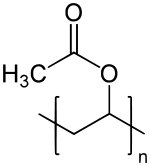Polyvinyl acetate
 | |
| Names | |
|---|---|
| IUPAC name
poly (1-acetyloxiethene) | |
| Other names
PVAc, PVA, Poly(ethenyl ethanoate), Poly(ethenyl acetate) | |
| Identifiers | |
3D model (JSmol) |
|
| ChemSpider |
|
| ECHA InfoCard | 100.108.147 |
| KEGG | |
PubChem CID |
|
| |
| Properties | |
| (C4H6O2)n | |
| Molar mass | 86.09 g/mol/unit |
| Density | 1.19 g/cm3 (25 °C) |
| Boiling point | 112 °C (234 °F; 385 K) |
| Hazards | |
| Safety data sheet | MSDS |
Except where otherwise noted, data are given for materials in their standard state (at 25 °C [77 °F], 100 kPa). | |
| Infobox references | |
Poly(vinyl acetate) (PVA, PVAc, poly(ethenyl ethanoate): commonly referred to as wood glue, white glue, carpenter's glue, school glue, Elmer's glue in the US, or PVA glue) is an aliphatic rubbery synthetic polymer with the formula (C4H6O2)n. It belongs to the polyvinyl esters family, with the general formula -[RCOOCHCH2]-. It is a type of thermoplastic.[1]
Properties
The degree of polymerization of poly(vinyl acetate) is typically 100 to 5000, while its ester groups are sensitive to base hydrolysis and slowly convert PVAc into polyvinyl alcohol and acetic acid.
PVAc emulsions such as Elmer's Glue-All contain polyvinyl alcohol as a protective colloid. In alkaline conditions, boron compounds such as boric acid or borax cause the polyvinyl alcohol to cross-link, forming tackifying precipitates or toys, such as Slime and Flubber.
A number of microorganisms can degrade polyvinyl acetate. Most commonly, damage is caused by filamentous fungi—however algae, yeasts, lichens, and bacteria can also degrade polyvinyl acetate.[2]
Discovery
Poly(vinyl acetate) was discovered in Germany in 1912 by Fritz Klatte.[3]
The monomer, vinyl acetate, was first produced on an industrial scale by the addition of acetic acid to acetylene with a mercury(I) salt[4] but it is now primarily made by palladium catalyzed oxidative addition of acetic acid to ethylene.
Preparation
PVA is a vinyl polymer. Polyvinyl acetate is prepared by the polymerization of vinyl acetate monomer (free radical vinyl polymerization of the monomer vinyl acetate).
Applications
As an emulsion in water, PVAc emulsions are used as adhesives for porous materials, particularly for wood, paper, and cloth, and as a consolidant for porous building stone, in particular sandstone.[5] Uses:
- as wood glue, PVAc is known as "white glue" and the yellow as "carpenter's glue".
- as paper adhesive during paper packaging conversion
- in bookbinding and book arts, due to its flexible strong bond and non-acidic nature (unlike many other polymers). The use of PVAc on the Archimedes Palimpsest during the 20th century greatly hindered the task of disbinding the book and preserving and imaging the pages in the early 21st century, in part because the glue was stronger than the parchment it held together.[6]
- in handicrafts
- as envelope adhesive
- as wallpaper adhesive
- as a primer for drywall and other substrates
The stiff homopolymer PVAc, but mostly the more soft copolymer, a combination of vinyl acetate and ethylene, vinyl acetate ethylene (VAE), is also used in paper coatings, paint and other industrial coatings, as a binder in nonwovens in glass fibers, sanitary napkins, filter paper and in textile finishing.
Polyvinyl acetate is also the raw material to make other polymers like:
- Polyvinyl alcohol -[HOCHCH2]-: Polyvinyl acetate is partially or completely hydrolysed to give polyvinyl alcohol. This reversible saponification and esterification reaction was a strong hint for Hermann Staudinger in the formulation of his theory of macromolecules.[7]
- Polyvinyl acetate phthalate (PVAP): Polyvinyl acetate is partially hydrolyzed and then esterified with phthalic acid.
See also
References
- ↑ Murray, G. T. (1997), Handbook of materials selection for engineering applications, CRC Press, p. 242, ISBN 978-0-8247-9910-6.
- ↑ Francesca Cappitelli; Claudia Sorlini (2008). "Microorganisms Attack Synthetic Polymers in Items Representing Our Cultural Heritage". Applied and Environmental Microbiology. 74: 564–9. doi:10.1128/AEM.01768-07. PMC 2227722. PMID 18065627.
- ↑ See:
(1) Deutsche Reichs Patent no. 281687 (4 July 1913), Journal of the Society of Chemical Industry (London), vol. 34, page 623 (1915);
(2) Deutsche Reichs Patent no. 281688 (2 April 1914);
(3) British Patent no. 15271 (25 June 1914.);
(4) Fritz Klatte and Adolf Rollett, "Plastic composition and process of producing it," U.S. Patent 1,241,738 (filed: July 3, 1914; issued: Oct. 2, 1917), an abstract of which appears in the Journal of the Society of Chemical Industry (London), vol. 36, page 1185 (1917). - ↑ Rutherford John Gettens and George Leslie Stout, Painting Materials: A Short Encyclopaedia (Princeton, New Jersey: D. Van Nostrand, 1942),page 74.
- ↑ Young ME, Murray M, Cordiner P (1999). "Stone consolidants and chemical treatments in Scotland". Robert Gordon University, Building Research Establishment and Historic Scotland. Retrieved 2009-07-30.
- ↑ "The Conservation of the Archimedes Palimpsest". The Walters Art Museum. 2011. Retrieved February 22, 2018.
- ↑ H. Staudinger, K. Frey, W. Stark, Ber. Deut. Chem. Ges. 1927, 60, 1782.